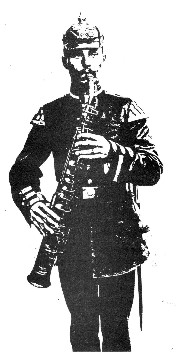Heckelphone-clarinet

The heckelphone-clarinet (or Heckelphon-Klarinette) is a rare woodwind instrument, invented in 1907 by Wilhelm Heckel in Wiesbaden-Biebrich, Germany. Despite its name, it is essentially a wooden saxophone with wide conical bore, built of red-stained maple wood, overblowing the octave, and with clarinet-like fingerings. It has a single-reed mouthpiece attached to a short metal neck, similar to an alto clarinet.[1] The heckelphone-clarinet is a transposing instrument in B♭ with sounding range of D3 (middle line of bass staff) to C6 (two ledger lines above the treble staff), written a whole tone higher. [2] The instrument is not to be confused with the heckel-clarina, also a very rare conical bore single reed woodwind by Heckel but higher in pitch and made of metal, nor with the heckelphone, a double reed instrument lower in pitch.
Timbre
[edit]The instrument sounds somewhat like a saxophone, but with a much softer tone. In his 1931 catalogue, Heckel asserts that "the clarinet-like tone of the instrument is excellent, extraordinarily harmonious, and powerful; nor is it sharp or metallic like that of the alto saxophone".[3] It was apparently intended for military use, but never became popular, and only between twelve and fifteen were manufactured.
References
[edit]- ^ Dullat, Günter (2001). Klarinetten: Grundzüge ihrer Entwicklung. Frankfurt am Main: Bochinsky.
- ^ Marcuse, Sibyl (1975). Musical Instruments: A Comprehensive Dictionary. New York: Norton.
- ^ Heckel, Wilhelm (1931). Über 100 Jahre Weltruf. Wiesbaden-Biebrich: Heckel.
External links
[edit]- Diagram of heckelphone-clarinet, heckel-clarina, and saxophone from 1931 Heckel catalog.
